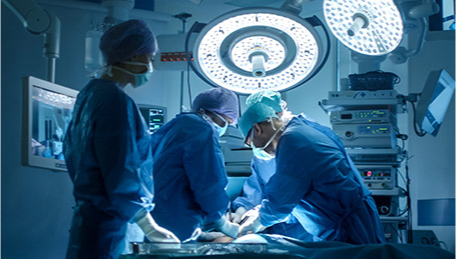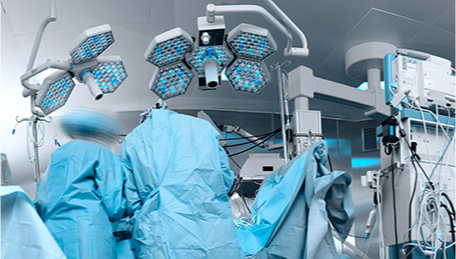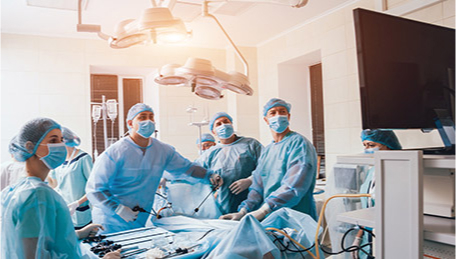Specialty Care
Tailored care for your surgical needs.

Overview
Many conditions are best treated by surgery, but it is best to know all your options. Discuss any questions and concerns you may have with your doctor as no question is too small. Be sure that you thoroughly understand the recommended procedure and why your doctor believes it is the right course of treatment for you. Never hesitate to get a second opinion from another surgeon if you are unsure about your options. The more informed you are, the more likely you are to be satisfied with the results of your treatment.
“Minimally invasive” means that instead of operating on patients through large incisions, doctors use miniaturized surgical instruments that fit through a series of quarter-inch incisions. Minimally invasive surgical techniques are offered as an alternative to traditional open surgery for a broad range of procedures and includes robotic and laparoscopic surgery.
With any procedure there is risk. Using minimally invasive techniques lowers such risk. In most cases, these techniques involve the use of small tubes called endoscopes, which often have miniature cameras built-in to direct the surgeon as he/she works. With minimally invasive surgery there is often less pain experienced with recovery and a faster recovery time.
Robotic surgery is a type of minimally invasive surgery. The surgeon controls the instruments and the camera from a console located in the operating room. Placing their fingers into the master controls, the physician is able to operate while watching a high-definition monitor providing a more detailed 3-D view of the operation site than the human eye can provide. Every movement the surgeon makes with the master controls is replicated precisely by the robot.
Laparoscopy is a type of surgery that uses smaller incisions than in traditional surgery. The surgeon makes several small incisions; usually each one is no more than a half-inch long. A tube is inserted through each opening in which the camera and surgical instruments enter. When the laparoscope is inserted, the surgeon can then look at a video monitor to guide their movements.
- If repairs simply cannot be made effectively using minimally invasive techniques
- If visual information is required to completely remove tissues or accurately diagnose a condition
- If your surgery requires access to larger areas
An appendectomy is the surgical removal of the appendix. It's a common emergency surgery that's performed to treat appendicitis, an inflammatory condition of the appendix.
An excisional biopsy is a diagnostic procedure used to determine if a breast disorder is benign or malignant. A Lumpectomy is performed when there is a known diagnosis of breast cancer and the mission is to remove all of the cancer with a healthy margin of tissue around the tumor.
Benign Breast Disorder
Non-cancerous (benign) breast disease affects nearly every woman at some point. Different benign breast conditions will affect your breast in different ways. However, all of them will cause some abnormal change. For this reason, it is vital to contact a medical professional if you have symptoms such as pain, irritation, a lump or tenderness.
Malignant Breast Disorder
Breast cancer surgery is a key component of breast cancer treatment that involves removing the cancer with an operation. Breast cancer surgery may be used alone or in combination with other treatments, such as chemotherapy, hormone therapy, targeted therapy and radiation therapy.
Your doctor will determine the best treatment plan for you based on multiple factors, including the location of the cancer in your colon or rectum and whether the cancer has spread to other organs. Today, doctors use two approaches for colon cancer surgery including traditional surgery and minimally invasive surgery . Additional treatment such as chemotherapy and radiation may also be required.
Colorectal surgery deals with disorders of the colon, rectum and anus. The most common disorders include diverticular disease, colon and rectal cancer and inflammatory bowel disease such as Crohn’s and ulcerative colitis. Although non-operative treatments are sometimes used to treat these conditions, you may require surgery.
This surgery is used to treat esophageal cancer, Barrett’s esophagus with high-grade dysplasia (pre-cancerous cells) or for end stage achalasia (failure of the muscles of the esophagus to relax, making it hard to swallow).
A fistula is a connection between two spaces which should not connect. An anal fistula is a small tunnel that connects the anus to an opening on the skin around the anus, and can be caused by infection, such as an abscess, and can also be related to Crohn’s disease. Surgery is almost always necessary to treat an anal fistula.
Your gallbladder helps digest food, and more specifically food that is greasy, fried and high in fat content. If it’s not working the way it should, hard fragments start to form. These are called gall stones. Only about 30% of people with gallstones will develop symptoms, such as upper abdominal pain, nausea or vomiting. However, about 80 percent of people who have symptoms from their gall stones will need surgery. Removal of the gall bladder, or cholecystectomy, is one of the most commonly performed surgeries in the United States and is performed both as a traditional surgical procedure and as a laparoscopic procedure.
A gastrointestinal endoscopy is a procedure used to visually examine your upper digestive system to diagnose and sometimes treat conditions that affect the esophagus, stomach and beginning of the small intestine.
Hemorrhoidectomy is surgery to remove hemorrhoids. There are different types of techniques to remove hemorrhoids. The most common is where incisions are made around the hemorrhoid tissue to remove it. The swollen hemorrhoid tissue, which involves a vein is tied off or burned to prevent bleeding and the hemorrhoid is removed. The specific type of procedure to remove hemorrhoids is decided between the surgeon and patient prior to surgery.
A hernia repair is the surgical procedure to repair a hernia, or weakness in the groin or the wall of the abdomen. A hernia occurs when part of an internal organ or body part protrudes into an area where it should not. The most common hernias occur in the abdominal, most commonly the navel or groin area. A small portion of the intestine, or more commonly a piece of fat, pokes through a weak area in the muscular wall of the abdomen or groin. This causes an abnormal bulge under the skin of the abdomen, usually near the groin or navel. Hernias can be repaired through a traditional surgical procedure or through a laparoscopic surgical procedure.
- bleeding
- scarring
- ulcers
- narrowing of the esophagus
Hiatal hernias can be repaired through a traditional surgical procedure or through a laparoscopic surgical procedure . This surgery has an estimated 90 percent success rate.
Cysts and lipomas form under the skin. Although they are fairly common and usually harmless, you should always consult a specialist if you find a lump on your skin. It is always important to have them checked to eliminate the possibility of a form of cancer. Most cysts and lipomas can be managed or removed surgically.
The most common reason for thyroid surgery is to remove a thyroid nodule which has been found to be suspicious. Surgery may be recommended if a biopsy shows cancer or possible cancer or is inconclusive. Surgery may be also recommended for nodules with benign biopsy results if the nodule is large, if it continues to increase in size or if it is causing symptoms (discomfort, difficulty swallowing, etc.).



